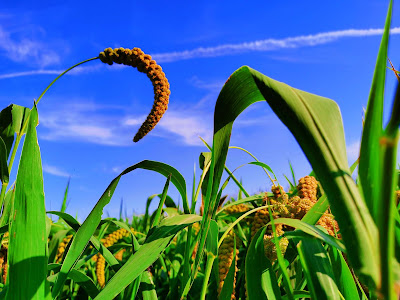During Chinese New Year holiday, you might have seen Chinese families put up couplets and 福 on their main doors to celebrate their most important holiday in a year.
Today we move on to explain what 福, which Chinese like the most, means and represents.
As we learned with 祝 at https://xiongzou.blogspot.com/2020/05/blog-post_23.html , left hand part of 福: 礻is Chinese Radical form of 示, which is the altar for worshiping, with details at https://xiongzou.blogspot.com/2020/04/blog-post_26.html. So we know that 福 should be related to worshiping gods.
Then what does right hand part of 福: 畐 mean? 畐 seems to be composed of 一口田. Does 福 mean to pray to gods for having a piece of farm land? With such questions in mind, let us examine the evolution history of 福 to understand 福 better:
 |
Evolution history of 福
|
Now we can see clearly from ancient scripts of 福 that its right hand side is the drawing of a wine vessel. It is particularly obvious with  in
in  and
and  in
in  . And during Bronze Script era, the vessel was simplified and transferred into
. And during Bronze Script era, the vessel was simplified and transferred into  , which was further simplified into 畐 in Seal Script.
, which was further simplified into 畐 in Seal Script.
Below is a typical traditional wine vessel used in ancient China:
Examining  carefully that we can see there is actually two hands
carefully that we can see there is actually two hands  offering
offering  onto altar. In 福's evolution process, the
onto altar. In 福's evolution process, the  was simplified away.
was simplified away.
福 is now obvious to have original meaning of offering wine to worship gods.
so 福 contains all the blessings, goodness and fortunes we pray to gods to grant us. To be more specific: Healthy, Wealthy, Safety and Peace. for example 福气.
And wine is brewed from rice. If an ancient Chinese family had extra rice to brew wine and not only that, they had wine reserved to offer to gods, it was a clear sign of blessing that this family got a bumper harvest. for example 祝福.
That is all for 福, time to enjoy a Chinese art with 福 inside:
 |
| 福 |


.jpg)


















 . And during Bronze Script era, the vessel was simplified and transferred into
. And during Bronze Script era, the vessel was simplified and transferred into 

 offering
offering 